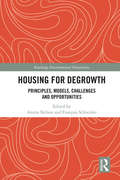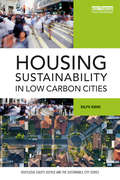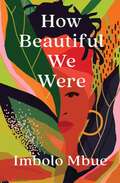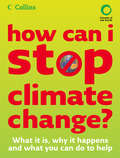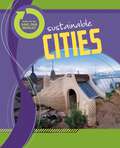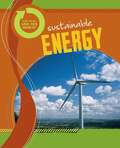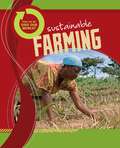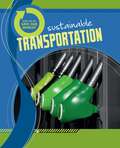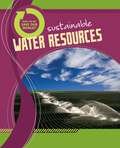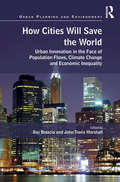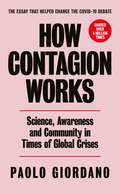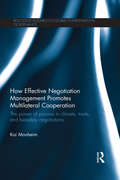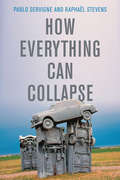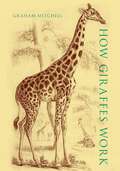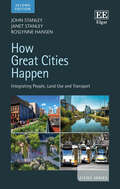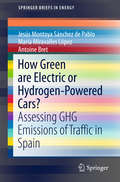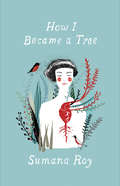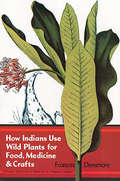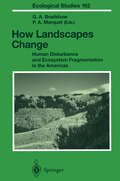- Table View
- List View
Housing for Degrowth: Principles, Models, Challenges and Opportunities (Routledge Environmental Humanities)
by Anitra Nelson François Schneider‘Degrowth’, a type of ‘postgrowth’, is becoming a strong political, practical and cultural movement for downscaling and transforming societies beyond capitalist growth and non-capitalist productivism to achieve global sustainability and satisfy everyone’s basic needs. This groundbreaking collection on housing for degrowth addresses key challenges of unaffordable, unsustainable and anti-social housing today, including going beyond struggles for a 'right to the city' to a 'right to metabolism', advocating refurbishment versus demolition, and revealing controversies within the degrowth movement on urbanisation, decentralisation and open localism. International case studies show how housing for degrowth is based on sufficiency and conviviality, living a ‘one planet lifestyle’ with a common ecological footprint. This book explores environmental, cultural and economic housing and planning issues from interdisciplinary perspectives such as urbanism, ecological economics, environmental justice, housing studies and policy, planning studies and policy, sustainability studies, political ecology, social change and degrowth. It will appeal to students and scholars across a wide range of disciplines.
Housing for Degrowth: Principles, Models, Challenges and Opportunities (Routledge Environmental Humanities)
by Anitra Nelson François Schneider‘Degrowth’, a type of ‘postgrowth’, is becoming a strong political, practical and cultural movement for downscaling and transforming societies beyond capitalist growth and non-capitalist productivism to achieve global sustainability and satisfy everyone’s basic needs. This groundbreaking collection on housing for degrowth addresses key challenges of unaffordable, unsustainable and anti-social housing today, including going beyond struggles for a 'right to the city' to a 'right to metabolism', advocating refurbishment versus demolition, and revealing controversies within the degrowth movement on urbanisation, decentralisation and open localism. International case studies show how housing for degrowth is based on sufficiency and conviviality, living a ‘one planet lifestyle’ with a common ecological footprint. This book explores environmental, cultural and economic housing and planning issues from interdisciplinary perspectives such as urbanism, ecological economics, environmental justice, housing studies and policy, planning studies and policy, sustainability studies, political ecology, social change and degrowth. It will appeal to students and scholars across a wide range of disciplines.
Housing Sustainability in Low Carbon Cities (Routledge Equity, Justice and the Sustainable City series)
by Ralph HorneHousing affordability, urban development and climate change responses are great challenges that are intertwined, yet the conceptual and policy links between them remain under-developed. Housing Sustainability in Low Carbon Cities addresses this gap by developing an interdisciplinary approach to urban decarbonisation, drawing upon more established, yet quite distinctive, fields of built environment policy and design, housing, and studies of social and economic change. Through this approach, policy and practices of housing affordability, equity, energy efficiency, resilience and renewables are critiqued and alternatives are presented. Drawing upon international case studies, this book provides a unique contribution to interdisciplinary urban and housing studies, discourses and practices in an era of climate change. This book is recommended reading on higher level undergraduate and taught postgraduate courses in architecture, urban studies, planning, built environment, geography and urban studies. It will also be directly valuable to housing and urban policy makers and sustainability practitioners.
Housing Sustainability in Low Carbon Cities (Routledge Equity, Justice and the Sustainable City series)
by Ralph HorneHousing affordability, urban development and climate change responses are great challenges that are intertwined, yet the conceptual and policy links between them remain under-developed. Housing Sustainability in Low Carbon Cities addresses this gap by developing an interdisciplinary approach to urban decarbonisation, drawing upon more established, yet quite distinctive, fields of built environment policy and design, housing, and studies of social and economic change. Through this approach, policy and practices of housing affordability, equity, energy efficiency, resilience and renewables are critiqued and alternatives are presented. Drawing upon international case studies, this book provides a unique contribution to interdisciplinary urban and housing studies, discourses and practices in an era of climate change. This book is recommended reading on higher level undergraduate and taught postgraduate courses in architecture, urban studies, planning, built environment, geography and urban studies. It will also be directly valuable to housing and urban policy makers and sustainability practitioners.
How Beautiful We Were: A Novel
by Imbolo Mbue'A formidable storyteller' JONATHAN FRANZEN Set in the fictional African village of Kosawa, How Beautiful We Were tells the story of a people living in fear amidst environmental degradation wrought by an American oil company. Pipeline spills have rendered farmlands infertile. Children are dying from drinking toxic water. Promises of clean-up and financial reparations are made – and ignored. The country’s government, led by a brazen dictator, exists to serve its own interest only. Left with few choices, the people of Kosawa decide to fight back. But their fight will come at a steep price . . . one which generation after generation will have to pay. Told through the perspective of a generation of children and the family of a girl named Thula, How Beautiful We Were is a masterful exploration of what happens when the reckless drive for profit, coupled with the ghost of colonialism, comes up against one community’s determination to hold onto its ancestral land and a young woman’s willingness to sacrifice everything for the sake of her people’s freedom.
How Can I Stop Climate Change: What Is It And How To Help
by Friends of the EarthDon’t just sit there, do something. But what? How Can I Stop Climate Change? explains what climate change is and what you can do to stop it. Written by the experts at Friends of the Earth, it gives you the facts and figures and offers practical advice and simple solutions.
How Can We Save Our World? Sustainable Cities (How Can We Save Our World?)
by Angela RoystonHow Can We Save Our World looks at how the idea of sustainable development is having an increasing influence on a wide range of human activities. The books examine the environmental costs and unsustainable nature of modern life, and discuss ways in which society can progress toward a more sustainable future.Sustainable Cities describes the development of cities from earliest times to the mega-cities of today. It discusses:€ The waste and pollution that make our cities unsustainable€ Building techniques that conserve energy and use waste and recycled materials€ Eco-communities that produce their own energy and reduce the need for travel€ How we can make existing cities greener and more sustainable.
How Can We Save Our World? Sustainable Energy (How Can We Save Our World?)
by Angela RoystonHow Can We Save Our World looks at how the idea of sustainable development is having an increasing influence on a wide range of human activities. The books examine the environmental costs and unsustainable nature of modern life, and discuss ways in which society can progress toward a more sustainable future.Sustainable Energy focuses on electricity and the way in which it is generated. It discusses:€ The pollution caused by fossil fuels, and the dwindling resources that make their use unsustainable€ The advantages and disadvantages of nuclear, water, and wind power€ Scientific methods of harnessing sustainable energy, such as solar and geothermal power€ Engineering innovations that can help us reduce the amount of energy we use.
How Can We Save Our World? Sustainable Farming (How Can We Save Our World?)
by Carol BallardHow Can We Save Our World looks at how the idea of sustainable development is having an increasing influence on a wide range of human activities. The books examine the environmental costs and unsustainable nature of modern life, and discuss ways in which society can progress toward a more sustainable future.Sustainable Farming describes the history of farming and explains why we need to make it more sustainable. It discusses:€ The environmental problems created by agriculture€ How the globalization of agriculture means that farm products are transported across the world€ Ways to make farming more sustainable€ How to achieve a balance between the needs of farmers, rural communities, consumers, and businesses.
How Can We Save Our World? Sustainable Tourism (How Can We Save Our World?)
by Andrew SolwayHow Can We Save Our World looks at how the idea of sustainable development is having an increasing influence on a wide range of human activities. The books examine the environmental costs and unsustainable nature of modern life, and discuss ways in which society can progress toward a more sustainable future.Sustainable Tourism describes the development of tourism from Roman times to the multi-million dollar industry of today. It discusses:€ The waste, over-consumption, and pollution that make tourism unsustainable€ Eco-friendly holidays that bring benefits to a region and help people learn about the importance of conservation€ Greenwashing-the abuse of ecotourism by profit-chasing businesses€ What we can do as tourists to conserve resources, benefit local people, and minimize our impact on the environment.
How Can We Save Our World? Sustainable Transportation (How Can We Save Our World?)
by Cath SenkerHow Can We Save Our World looks at how the idea of sustainable development is having an increasing influence on a wide range of human activities. The books examine the environmental costs and unsustainable nature of modern life, and discuss ways in which society can progress toward a more sustainable future.Sustainable Transportation describes the development of modern transportation systems and looks at the impact they have on the environment. It discusses:€ The emissions that make current forms of transportation unsustainable€ Vehicle designs that can improve fuel efficiency and reduce pollution€ Schemes that can reduce traffic congestion and help develop more integrated transportation systems€ Ways to reduce our dependency on polluting transportation methods.
How Can We Save Our World? Sustainable Water Resources (How Can We Save Our World?)
by Anne RooneyHow Can We Save Our World looks at how the idea of sustainable development is having an increasing influence on a wide range of human activities. The books examine the environmental costs and unsustainable nature of modern life, and discuss ways in which society can progress toward a more sustainable future.Sustainable Water Resources describes the origins of the world's water and how we use water in our homes, industries, and agriculture. It discusses:€ The pressures on the water supply today€ How water shortages affect people's lives€ Technological solutions for providing clean water and processing water€ How we can use water more efficiently to ensure there is enough for all.
How Cities Will Save the World: Urban Innovation in the Face of Population Flows, Climate Change and Economic Inequality (Urban Planning and Environment)
by Ray Brescia John Travis MarshallCities are frequently viewed as passive participants to state and national efforts to solve the toughest urban problems. But the evidence suggests otherwise. Cities are actively devising innovative policy solutions and they have the potential to do even more. In this volume, the authors examine current threats to communities across the U.S. and the globe. They draw on first-hand experience with, and accounts of, the crises already precipitated by climate change, population shifts, and economic inequality. This volume is distinguished, however, by its central objective of traveling beyond a description of problems and a discussion of their serious implications. Each of the thirteen chapters frame specific recommendations and guidance on the range of core capacities and interventions that 21st Century cities would be prudent to consider in mapping their immediate and future responses to these critical problems. How Cities Will Save the World brings together authors with frontline experience in the fields of city redevelopment, urban infrastructure, healthcare, planning, immigration, historic preservation, and local government administration. They not only offer their ground level view of threats caused by climate change, population shifts, and economic inequality, but they provide solution-driven narratives identifying promising innovations to help cities tackle this century’s greatest adversities.
How Cities Will Save the World: Urban Innovation in the Face of Population Flows, Climate Change and Economic Inequality (Urban Planning and Environment)
by Ray Brescia John Travis MarshallCities are frequently viewed as passive participants to state and national efforts to solve the toughest urban problems. But the evidence suggests otherwise. Cities are actively devising innovative policy solutions and they have the potential to do even more. In this volume, the authors examine current threats to communities across the U.S. and the globe. They draw on first-hand experience with, and accounts of, the crises already precipitated by climate change, population shifts, and economic inequality. This volume is distinguished, however, by its central objective of traveling beyond a description of problems and a discussion of their serious implications. Each of the thirteen chapters frame specific recommendations and guidance on the range of core capacities and interventions that 21st Century cities would be prudent to consider in mapping their immediate and future responses to these critical problems. How Cities Will Save the World brings together authors with frontline experience in the fields of city redevelopment, urban infrastructure, healthcare, planning, immigration, historic preservation, and local government administration. They not only offer their ground level view of threats caused by climate change, population shifts, and economic inequality, but they provide solution-driven narratives identifying promising innovations to help cities tackle this century’s greatest adversities.
How Contagion Works: Science, Awareness and Community in Times of Global Crises - The essay that helped change the Covid-19 debate
by Paolo GiordanoThe Covid-19 pandemic is the most significant health emergency of our time.Writing from Italy in lockdown, physicist and novelist Paolo Giordano explains how disease spreads in our interconnected world: why it mattershow it impacts ushow we must reactExpanding his focus to include other forms of contagion - from the environmental crisis to fake news and xenophobia - Giordano shows us not just how we got here but also how we can work together to create change.Paolo Giordano is a physicist and the author of four bestselling novels. His article 'The Mathematics of Contagion' - published in Italy at the beginning of the Covid-19 emergency - was shared more than 4 million times and helped shift public opinion in the early stages of the epidemic.
How Effective Negotiation Management Promotes Multilateral Cooperation: The power of process in climate, trade, and biosafety negotiations (Routledge Research in Global Environmental Governance)
by Kai MonheimMultilateral negotiations on worldwide challenges have grown in importance with rising global interdependence. Yet, they have recently proven slow to address these challenges successfully. This book discusses the questions which have arisen from the highly varying results of recent multilateral attempts to reach cooperation on some of the critical global challenges of our times. These include the long-awaited UN climate change summit in Copenhagen, which ended without official agreement in 2009; Cancún one year later, attaining at least moderate tangible results; the first salient trade negotiations after the creation of the WTO, which broke down in Seattle in 1999 and were only successfully launched in 2001 in Qatar as the Doha Development Agenda; and the biosafety negotiations to address the international handling of Living Modified Organisms, which first collapsed in 1999, before they reached the Cartagena Protocol in 2000. Using in-depth empirical analysis, the book examines the determinants of success or failure in efforts to form regimes and manage the process of multilateral negotiations. The book draws on data from 62 interviews with organizers and chief climate and trade negotiators to discover what has driven delegations in their final decision on agreement, finding that with negotiation management, organisers hold a powerful tool in their hands to influence multilateral negotiations. This comprehensive negotiation framework, its comparison across regimes and the rich and first-hand empirical material from decision-makers make this invaluable reading for students and scholars of politics, international relations, global environmental governance, climate change and international trade, as well as organizers and delegates of multilateral negotiations. This research has been awarded the German Mediation Scholarship Prize for 2014 by the Center for Mediation in Cologne.
How Effective Negotiation Management Promotes Multilateral Cooperation: The power of process in climate, trade, and biosafety negotiations (Routledge Research in Global Environmental Governance)
by Kai MonheimMultilateral negotiations on worldwide challenges have grown in importance with rising global interdependence. Yet, they have recently proven slow to address these challenges successfully. This book discusses the questions which have arisen from the highly varying results of recent multilateral attempts to reach cooperation on some of the critical global challenges of our times. These include the long-awaited UN climate change summit in Copenhagen, which ended without official agreement in 2009; Cancún one year later, attaining at least moderate tangible results; the first salient trade negotiations after the creation of the WTO, which broke down in Seattle in 1999 and were only successfully launched in 2001 in Qatar as the Doha Development Agenda; and the biosafety negotiations to address the international handling of Living Modified Organisms, which first collapsed in 1999, before they reached the Cartagena Protocol in 2000. Using in-depth empirical analysis, the book examines the determinants of success or failure in efforts to form regimes and manage the process of multilateral negotiations. The book draws on data from 62 interviews with organizers and chief climate and trade negotiators to discover what has driven delegations in their final decision on agreement, finding that with negotiation management, organisers hold a powerful tool in their hands to influence multilateral negotiations. This comprehensive negotiation framework, its comparison across regimes and the rich and first-hand empirical material from decision-makers make this invaluable reading for students and scholars of politics, international relations, global environmental governance, climate change and international trade, as well as organizers and delegates of multilateral negotiations. This research has been awarded the German Mediation Scholarship Prize for 2014 by the Center for Mediation in Cologne.
How Everything Can Collapse: A Manual for our Times
by Pablo Servigne Raphael StevensWhat if our civilization were to collapse? Not many centuries into the future, but in our own lifetimes? Most people recognize that we face huge challenges today, from climate change and its potentially catastrophic consequences to a plethora of socio-political problems, but we find it hard to face up to the very real possibility that these crises could produce a collapse of our entire civilization. Yet we now have a great deal of evidence to suggest that we are up against growing systemic instabilities that pose a serious threat to the capacity of human populations to maintain themselves in a sustainable environment.In this important book, Pablo Servigne and Raphaël Stevens confront these issues head-on. They examine the scientific evidence and show how its findings, often presented in a detached and abstract way, are connected to people’s ordinary experiences – joining the dots, as it were, between the Anthropocene and our everyday lives. In so doing they provide a valuable guide that will help everyone make sense of the new and potentially catastrophic situation in which we now find ourselves. Today, utopia has changed sides: it is the utopians who believe that everything can continue as before, while realists put their energy into making a transition and building local resilience. Collapse is the horizon of our generation. But collapse is not the end – it’s the beginning of our future. We will reinvent new ways of living in the world and being attentive to ourselves, to other human beings and to all our fellow creatures.
How Giraffes Work
by Graham MitchellThere are few creatures more beautiful, aloof, and fascinating than giraffes. Their social and ecological impact has been documented by many researchers. However, the inner workings of extant giraffes are less well known. That is why Graham Mitchell decided to write How Giraffes Work: a comprehensive overview of the anatomy, physiology, and biochemistry--in short, the normal functions--of a free-living, wild animal in its natural environment. A zoologist, veterinarian, and physiologist, Mitchell explains how giraffes get through their day. Additionally, he takes readers through the evolution of their physical characteristics, such as their size, shape, and coat markings. His approach integrates history with the physiology, anatomy, biochemistry, behavior, evolution, genetics, ecology, climate science, and more. Each chapter follows the discovery and utility of a different characteristic of giraffes. Illustrated with over two hundred figures and diagrams, the book explains how giraffes might have evolved and survived over many millions of years as well as how our perception of them has changed throughout history. So, how do giraffes work? The answers lie in a story filled not only with the details of their internal working but also with the labors of the extraordinary scientists who have put so many pieces of this puzzle together.
How Giraffes Work
by Graham MitchellThere are few creatures more beautiful, aloof, and fascinating than giraffes. Their social and ecological impact has been documented by many researchers. However, the inner workings of extant giraffes are less well known. That is why Graham Mitchell decided to write How Giraffes Work: a comprehensive overview of the anatomy, physiology, and biochemistry--in short, the normal functions--of a free-living, wild animal in its natural environment. A zoologist, veterinarian, and physiologist, Mitchell explains how giraffes get through their day. Additionally, he takes readers through the evolution of their physical characteristics, such as their size, shape, and coat markings. His approach integrates history with the physiology, anatomy, biochemistry, behavior, evolution, genetics, ecology, climate science, and more. Each chapter follows the discovery and utility of a different characteristic of giraffes. Illustrated with over two hundred figures and diagrams, the book explains how giraffes might have evolved and survived over many millions of years as well as how our perception of them has changed throughout history. So, how do giraffes work? The answers lie in a story filled not only with the details of their internal working but also with the labors of the extraordinary scientists who have put so many pieces of this puzzle together.
How Great Cities Happen: Integrating People, Land Use and Transport (Cities series)
by John Stanley Janet Stanley Roslynne HansenUrban planners in developed countries are increasingly recognizing the need for closer integration of land use and transport. However, this updated second edition of How Great Cities Happen explains how crises like climate change and the lack of affordable housing demonstrate the urgent need for a broader approach in order to create and sustain great cities.Offering innovative solutions to these contemporary challenges, this second edition of How Great Cities Happen examines new and emerging directions in strategic land use transport planning and analyses how cities function as a home for future generations and other species. Taking an integrated approach, and building on the first edition, chapters explore a broad range of issues concerning strategic urban planning. These include planning for productivity growth; social inclusion and wellbeing, with a particular focus on planning cities for children and youth; housing affordability; environmental sustainability; and integrated governance and funding arrangements. New issues covered in this edition include pressing concerns like climate change and biodiversity protection. The authors adopt a meticulous yet non-technical and accessible approach, grounded in a blend of academic and real-world experience of cities.This transdisciplinary second edition will prove vital to students and scholars of urban planning, transport economics, and social and environmental policy, alongside professional planners and urban policymakers.
How Green are Electric or Hydrogen-Powered Cars?: Assessing GHG Emissions of Traffic in Spain (SpringerBriefs in Energy)
by Jesús Montoya Sánchez de Pablo María Miravalles López Antoine BretHave you ever wondered by how much CO2 emissions can be reduced by running cars electrically or with hydrogen as fuel? This Brief provides a quantitative answer to this question using the example of the combined road traffic in Spain. The authors calculate the resulting greenhouse gas (GHG) emissions for the production of hydrogen gas or the required electricity and installing and maintaining the necessary infrastructure. In this way, they can compare with the GHG emissions in the present situation of oil fueled cars. Using different scenarios, they obtain an assessment how much ‘greener’ the electric or hydrogen cars can get.The method described in this Brief is scalable and readily adaptable to other countries. It can thus be used for investigating sensible approaches and developing recommendations for a conversion. As expected, the results depend strongly on the production scenarios for hydrogen or electricity production. The wrong choice can even result in increased GHG emissions. A proper choice of the roadmap toward a more sustainable and greener future is of greatest importance – the results described in this Brief can serve as a valuable and useful guide on our way.
How I Became a Tree
by Sumana RoyAn exquisite, lovingly crafted meditation on plants, trees, and our place in the natural world, in the tradition of Robin Wall Kimmerer’s Braiding Sweetgrass and Annie Dillard’s Pilgrim at Tinker Creek “I was tired of speed. I wanted to live tree time.” So writes Sumana Roy at the start of How I Became a Tree, her captivating, adventurous, and self-reflective vision of what it means to be human in the natural world. Drawn to trees’ wisdom, their nonviolent way of being, their ability to cope with loneliness and pain, Roy movingly explores the lessons that writers, painters, photographers, scientists, and spiritual figures have gleaned through their engagement with trees—from Rabindranath Tagore to Tomas Tranströmer, Ovid to Octavio Paz, William Shakespeare to Margaret Atwood. Her stunning meditations on forests, plant life, time, self, and the exhaustion of being human evoke the spacious, relaxed rhythms of the trees themselves. Hailed upon its original publication in India as “a love song to plants and trees” and “an ode toall that is unnoticed, ill, neglected, and yet resilient,” How I Became a Tree blends literary history, theology, philosophy, botany, and more, and ultimately prompts readers to slow down and to imagine a reenchanted world in which humans live more like trees.
How Indians Use Wild Plants for Food, Medicine & Crafts
by Frances Densmore"Learn the natural ways of the Chippewa Indians with this great book from Dover." — Texas Kitchen and Garden and MoreThe uses of plants — for food, for medicine, for arts, crafts, and dyeing — among the Chippewa Indians of Minnesota and Wisconsin show the great extent to which they understood and utilized natural resources. In this book those traditions are captured, providing a wealth of new material for those interested in natural food, natural cures, and native crafts.In separate sections describing the major areas of use, Miss Densmore, an ethnologist with the Smithsonian Institution, details the uses of nearly 200 plants with emphasis on wild plants and lesser-known uses. For those interested in natural foods she gives extensive coverage to the gathering and preparation of maple sugar and wild rice, as well as preparations for beverages from leaves and twigs of common plants, seasonings including mint and bearberry, the methods of preparing wild rice and corn, cultivated and wild vegetables, and wild fruits and berries. On Indian medicines she tells the basic methods of gathering plants and the basic surgical and medical methods. Then she gives a complete list of the plants with their botanical names, uses, parts used, preparation and administration, and other notes and references. Also covered are plants used as charms, plants used in natural dyes, and plants in the useful and decorative arts including uses for household items, toys, mats, twine, baskets, bows, and tools, with special emphasis on the uses of birch bark and cedar. This section will be especially useful for supplying new and unusual craft ideas. In addition, 36 plates show the many stages of plant gathering and preparation and many of the artistic uses. While a number of the plants discussed are native only to the Great Lakes region, many are found throughout a wide range.Those studying the Indians of the Great Lakes region, or those trying to get back to nature through understanding and using natural materials, will find much about the use of plants in all areas of community life. Because of Miss Densmore’s deep knowledge and clear presentation, her study remains a rich and useful source for learning about or using native foods, native cures, and native crafts.
How Landscapes Change: Human Disturbance and Ecosystem Fragmentation in the Americas (Ecological Studies #162)
by K. L. RonnenbergNorth and South America share similar human and ecological histories and, increasingly, economic and social linkages. As such, issues of ecosystem functions and disruptions form a common thread among these cultures. This volume synthesizes the perspectives of several disciplines, such as ecology, anthropology, economy, and conservation biology. The chief goal is to gain an understanding of how human and ecological processes interact to affect ecosystem functions and species in the Americas. Throughout the text the emphasis is placed on habitat fragmentation. At the same time, the book provides an overview of current theory, methods, and approaches used in the analysis of ecosystem disruptions and fragmentation.
